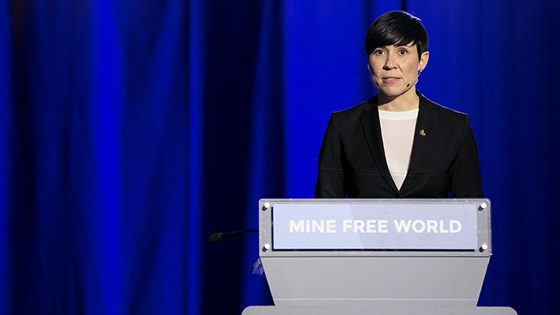Åpningsinnlegg på Tilsynskonferansen for minekonvensjonen
Historisk arkiv
Publisert under: Regjeringen Solberg
Utgiver: Utenriksdepartementet
Tale/innlegg | Dato: 25.11.2019
Av: Tidligere utenriksminister Ine Eriksen Søreide (Oslo, 25. november)
Utenriksminister Ine Eriksen Søreides åpningsinnlegg under Tilsynskonferansen for minekonvensjonen som åpnet i Oslo 25. november.

Your Royal Highnesses,
Excellencies,
Ladies and gentlemen,
The Mine Ban Convention is one of the most successful disarmament treaties of recent times.
Over the past 20 years, 31 States Parties have completed clearance of all mines on their territory.
At least 2 880 square kilometres of mined areas have been cleared.
More than 4.6 million anti-personnel mines removed from the ground.
And almost 53 million stockpiled mines have been destroyed.
In addition to these huge achievements, the rights of victims and survivors have been recognised, and a great many people have been given the help they deserve.
***
I am truly proud to welcome the Mine Ban Convention back to Oslo.
A special welcome to the many survivors and representatives of victims’ associations present here today.
The Convention text was adopted here in Oslo on 18 September 1997. It has been an honour for Norway to hold the presidency of the Mine Ban Convention – again- for the past 12 months.
We are proud to be working with the 164 States Parties, the international organisations and civil society actors.
Our common goal is a world free of landmines.
***
At the last Review Conference in Maputo five years ago, we agreed on the ambitious goal of a mine-free world by 2025.
I say ambitious, not impossible.
The Convention has established a strong norm against any use of anti-personnel landmines.
The voting patterns for the annual UN resolution on the implementation of the Convention clearly show that the Convention is respected by many more countries than there are State Parties.
***
Nevertheless, many established norms are currently under pressure. Taking established agreements and norms for granted is something we cannot afford to do.
Let there be no doubt, the norms established by the Mine Ban Convention still stand strong. But this does not mean that they are unchallenged.
Overall, we have seen a clear trend of declining numbers of casualties due to landmines in most countries since the Convention entered into force.
But in a few countries affected by armed conflict —Afghanistan, Libya, Nigeria, Syria, and Ukraine, as well as Myanmar – there has been a significant increase in the number of recorded casualties since 2014.
Landmines are not a problem of the past.
I am deeply concerned that it is an increasing trend by non-state actors to terrorize civilians by using improvised landmines in far greater numbers and varieties than ever before.
They are designed for one purpose: to target innocent civilians. Hidden in furniture, schools, and toys. Designed to kill and maim. 71 per cent of the victims are civilians. 54 per cent of those registered injured are children.
Countries such as Afghanistan and Iraq, which were already heavily contaminated by mines, are now experiencing a new emergency.
The increase in casualties is closely linked to new use of forbidden anti-personnel mines – often improvised explosive devices or homemade mines - made by non-state actors, such as ISIS. And made with increasing sophistication.
***
The rise in casualties shows us that focus on both prevention and effective mine risk education is imperative. And protection has been a priority for the Norwegian presidency.
Another priority has been to speed up the pace of clearance.
As of October this year, 56 countries and 3 other areas are still contaminated by landmines. 34 of these countries are party to the Mine Ban Convention.
The Convention sets clear deadlines for clearance, and in more than half of these 34 countries, encouraging progress has been made.
We all have a responsibility to help those affected. Funding for mine action is required, but funding is not enough on its own. We also need policies and national ownership.
National ownership is vital for gaining an accurate picture of the extent of contamination of land mines.
***
There is one final priority for Norway’s presidency that I would like to mention today: ensuring gender equality in all aspects of mine action.
We are on a mission to move gender from the side events to the plenary session.
Our aim is that the Mine Ban Convention should set a positive example for the disarmament sector as a whole.
***
Norway has been supporting mine action for 25 years.
We are currently funding mine action in 20 countries, in close partnership with humanitarian NGOs that do an outstanding job on the ground.
Our financial humanitarian contributions was about USD 40 million in 2019.
We will continue this engagement.
We will not give up until the last mine has been cleared and all victims receive the assistance they need.
On Friday, we will adopt the Oslo Action Plan.
We hope this will give new energy to the implementation of the Mine Ban Convention.
The draft Action Plan encourages accountability in a way that has not been done before.
It addresses cross-cutting issues, national ownership, protection, and the links between mine action and the Sustainable Development Goals.
***
At the beginning of my speech I gave you the statistics: Areas cleared, mines dug up, and millions of stockpiles of mines destroyed.
But what does those statistics really mean?
Every single one of those numbers represent someone’s foot, someone’s arm or someone’s life – that could have been lost to mines.
***
Let us work together for a strong outcome document here in Oslo. I urge all delegates to use the coming days to push for progress in implementing all obligations under the Mine Ban Convention.
And while 164 countries have already signed up to the Convention, I call on the remaining countries who have not already done so, to join the Convention.
Our goal is a world free of landmines.
Thank you.